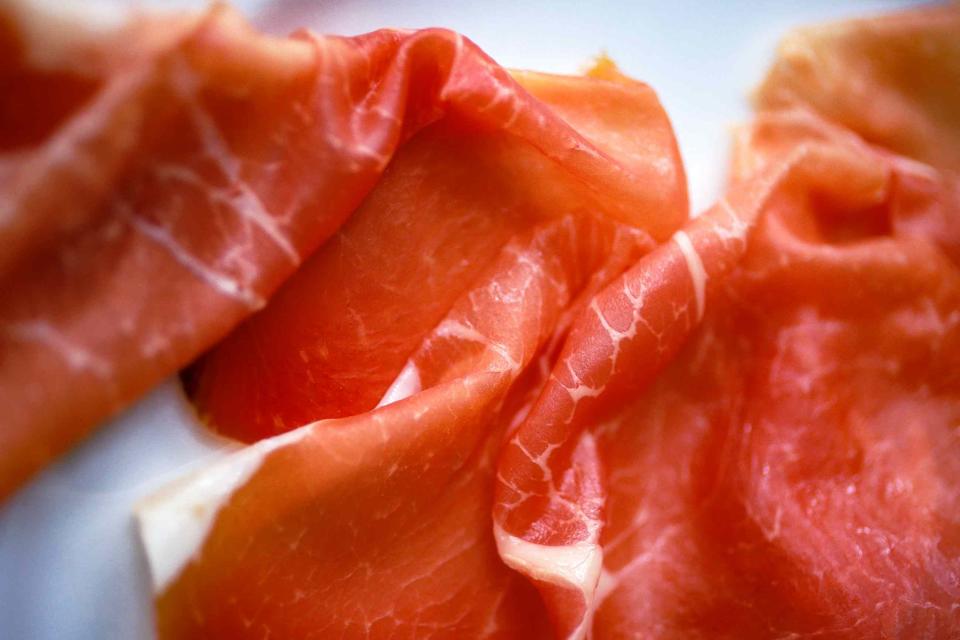The Rare Italian Ham You Absolutely Need in Your Life
The earthy, centuries-old salumi was only introduced to the U.S. in 2017, though Italy has been enjoying it since the Middle Ages.

Bob Sacha / Getty Images
For as long as pigs have roamed the Italian countryside, Prosciutto di Parma has reigned supreme over the international delicatessen. No respectable Italian charcuterie board comes complete without the mild, sweet cured ham, which is a PDO (Protected Designation of Origin) product. But Italy has been keeping another closely guarded meat secret for centuries: PDO Culatello di Zibello.
Found near Parma in the north of Emilia-Romagna, the same food-obsessed region that gifted the world with prosciutto and Parmigiano Reggiano, culatello is a rare, small salumi made from the choicest section of the thigh muscle, from the rear to the inner leg. (Hence the name, culatello, which translates to “little ass.”)
The production process hasn’t changed much since the Middle Ages, requiring little more than time and patience. First, the meat is massaged with black pepper, garlic, and an unholy amount of salt. The cut is then wrapped in a clean pig’s bladder — much like the use of intestines as a casing for a sausage — and neatly hung in a natural cord net to cure for at least ten months in a dank cellar where climate and humidity are controlled by the methodical opening and closing of small windows. Aging in a cold-wet climate along the banks of the Po river is essential; it allows mold to develop over the culatello casing, lending the meat its complex flavor.
RELATED: 7 Ways to Channel Your Inner Stanley Tucci in Italy's 'Food Valley'
At Antica Corte Pallavicina, one of just 23 producers in nine towns certified to make culatello, the cellars have been hard at work turning out artisanal salami for roughly 700 years. In their depths, 5,000 hams hang like porcine piñatas, forcing curious visitors to duck as they wind through swaying rows of meat. The smell of the mold can feel overwhelming. But hand-sliced and served alone or over hot gnocco fritto, the taste of the final product is much more appetizing. Where prosciutto softens, culatello melts away. Velvety and lardo-like in texture, the meat breaks apart in your fingers and mouth, leaving behind a funky, briny quality that makes other salami seem one-note in comparison. The older the culatello, the earthier its properties, much like a well-aged cheese.
With so few suppliers, there are plenty of connoisseurs around the world clamoring to stock up on this Italian delicacy. Antica Corte Pallavicina counts Alain Ducasse, King Charles, and George Clooney among its many fans. The rest of the world is starting to catch on, too. Despite its storied background, culatello was only recently introduced to the United States in 2017 when the Department of Agriculture approved it for import. Now, it’s possible to buy the real thing at Italian specialty stores such as Di Palo’s Fine Foods in New York City and Eataly (and even a shop on Amazon.)
RELATED: If You Eat One Cheese in Tuscany, Let It Be This
Beware imitations: Some salumerias in the U.S. make an unofficial version aged in climate-controlled rooms. But it’s impossible to create true culatello outside of Parma’s lowlands, the only place you can find a crucial, hyper-local ingredient: Po river fog. By enveloping the area where the salami is produced, the fog naturally guides the cellar molds and environment needed to perfect culatello’s flavor. Purists — and the Consortium of Culatello di Zibello — claim that the closer to the River, the better the culatello. Across the Atlantic doesn’t quite make the cut.

